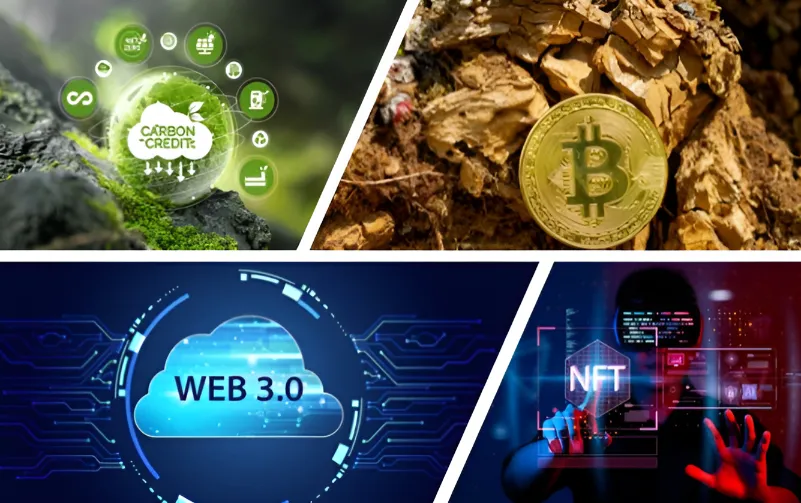As we reach the midpoint of this decade and move towards 2030, three major macro trends are set to significantly impact businesses and everyday life: the introduction of digital currencies and transactions, Web 3.0 and blockchain, and the carbon economy. However, These trends will collectively cause a seismic shift in how we operate, transact, and think about sustainability.
For most, being carbon neutral is just a concept, let alone knowing what their footprint is and how they’re going to get there in the next 10, 20, or 30 years.
Digital Currencies and Transactions
Digital currencies, including central bank digital currencies (CBDCs) and cryptocurrencies, are becoming increasingly mainstream. So, these new forms of currency promise to revolutionize the financial system.
Implications
– Efficiency and Speed: Digital currencies can enable faster and cheaper transactions, reducing the need for intermediaries.
– Financial Inclusion: They can provide financial services to unbanked populations, increasing economic participation.
– Regulatory Changes: Governments and regulatory bodies will need to adapt to these new forms of currency, impacting how businesses operate and comply with financial regulations.
– Real-time Transparency: Instant transparency of all transactions will enable governments to capture your carbon footprint in real time based on purchasing behaviors.
Web 3.0 and Blockchain
Web 3.0 represents the next evolution of the internet, characterized by decentralized protocols and blockchain technology. However, this shift aims to create a more open, trustless, and user-centric internet.
Implications
– Decentralization: Users’ data and power are no longer centralized but distributed instead, thereby limiting big tech companies’ control and enhancing privacy and security for users.
– Smart Contracts: Automated, self-executing contracts reduce the need for intermediaries and increase efficiency in transactions and agreements.
– New Business Models: Web 3.0 enables the creation of real-time carbon recording and trading.
The Carbon Economy
The carbon economy is emerging as a crucial framework for managing and reducing greenhouse gas emissions. This includes carbon pricing mechanisms such as carbon taxes and carbon trading markets.
Implications
– Environmental Responsibility: Businesses will need to account for and reduce their carbon emissions to comply with regulations and meet consumer expectations.
– Innovation and Investment: There will be increased investment in green technologies and sustainable practices as companies strive to lower their carbon footprint.
– New Markets: The carbon economy will create new markets for carbon credits and offset projects, offering opportunities for businesses to engage in sustainability initiatives.
Seismic Shift
Integrated Impact
These three macro trends are interconnected and will collectively reshape the landscape:
– Digital Currencies and Carbon Trading: Digital currencies and blockchain can facilitate transparent and efficient carbon trading markets, making it easier to track and verify carbon credits.
– Blockchain and Carbon Accounting: Blockchain technology can provide a secure and transparent way to track carbon emissions and ensure accountability in carbon accounting.
– Web 3.0 and Sustainability: Decentralized platforms can support community-driven sustainability initiatives and empower individuals and organizations to participate in the carbon economy.
So How Do I Know What My Footprint Is?
In carbon accounting, emissions are categorized into three scopes, as defined by the Greenhouse Gas (GHG) Protocol. These scopes help organizations measure and manage their greenhouse gas emissions.
1 Scope : Direct Emissions
– Emissions from sources that are owned or controlled by the company. Examples include emissions from combustion in owned or controlled boilers, furnaces, vehicles, and emissions from chemical production in owned or controlled process equipment.
2 Scope : Indirect Emissions from Energy
– Emissions from the generation of purchased electricity, steam, heating, and cooling consumed by the company. These emissions occur at the facility where the energy is produced but are attributed to the company because they result from its energy use.
3 Scope : Other Indirect Emissions
– All other indirect emissions that occur in a company’s value chain. Examples include emissions from purchased goods and services, business travel, employee commuting, waste disposal, use of sold products, transportation and distribution (upstream and downstream), and investments.
By understanding and managing emissions across all three scopes, companies can develop comprehensive strategies to reduce their carbon footprint and contribute to climate change mitigation.
Carbon Offsetting Initiatives
Having undertaken a carbon audit and worked on Scope 1, 2, and 3 emissions, most organizations will realize that they still fall short of their necessary targets. This will require carbon offsetting initiatives.
What is a Carbon Offset?
A carbon offset is a reduction in greenhouse gas emissions—such as carbon dioxide (CO₂)—made in order to compensate for or offset an emission produced elsewhere. It is a way for individuals, companies, and organizations to mitigate their carbon footprint by investing in environmental projects that reduce or sequester carbon emissions. However, these projects can take various forms, including renewable energy, energy efficiency, reforestation, and conservation efforts.
Key Components of Carbon Offsets
1. Measurement:
– The amount of carbon dioxide equivalent (CO₂e) emissions reduced or avoided by a project is calculated.
2. Verification:
– Independent third parties verify the emission reductions to ensure they are real, measurable, and permanent.
3. Certification:
– Verified emission reductions are certified by recognized standards, such as the Verified Carbon Standard (VCS), Gold Standard, or the Clean Development Mechanism (CDM).
4. Issuance:
– Certified emission reductions are issued as carbon credits, which represent a specific amount of CO₂e reduced (typically one ton of CO₂e per credit).
5. Retirement:
– To offset emissions, carbon credits are retired, meaning they are permanently removed from the market and cannot be reused.
Understanding The Carbon Scheme
Individuals organizations and companies will be required to measure their carbon footprint, this will be broken down into three categories.
1 Scope – Covers direct emissions from owned or controlled sources.
2 Scope –Covers indirect emissions from the generation of purchased electricity, steam, heating and cooling consumed by the reporting company.
3 Scope – Includes all other indirect emissions that occur in a company’s value chain.
Everyone will be required to be “carbon neutral” or will be fined / taxed accordingly.
This means organizations will be required to reduce their footprint where they can.
Offsets Initiatives
1/ The best initiatives directly produce carbon positive activities/programs that generate credits and not only offset for neutral status but generates surplus credits that can be traded and sold.
2/ Find carbon reducing efficiencies internally directly reduce emissions
3/ Reduce upstream activities or can indirectly trade or acquire carbon positive credits from within their own supply chain or offset by buying third party credits.
4/ Reduce downstream activities and can indirectly or directly produce their own carbon positive credits by generating carbon positive programs.
5/ Buy credits from open market to offset emissions.

There are five key steps to achieving one of our certifications. Click the icons to learn more about each step of the process.

Types of Carbon Offset Projects
1. Renewable Energy:
– Projects that generate energy from renewable sources such as wind, solar, and hydropower, displacing the need for fossil fuel-based energy generation.
2. Energy Efficiency:
– Initiatives that improve energy efficiency in buildings, industrial processes, and transportation, reducing overall energy consumption and associated emissions.
3. Reforestation and Afforestation:
– Planting trees to absorb CO₂ from the atmosphere. In areas that were once deforested, reforestation is the process of planting trees. Afforestation, on the other hand, refers to the act of planting trees in areas that have never been forested before.
4. Methane Capture:
– Projects that capture methane emissions from landfills, agriculture, and other sources, preventing this potent greenhouse gas from entering the atmosphere.
5. Forest Conservation:
– Efforts to prevent deforestation and degradation of forests, which are critical carbon sinks.
Benefits of Carbon Offsets
1. Environmental Impact:
– Offsets help reduce global greenhouse gas emissions and mitigate climate change.
2. Economic Benefits:
– Carbon offset projects can generate income and create jobs, particularly in developing countries.
3. Corporate Responsibility:
– Companies can demonstrate their commitment to sustainability and meet regulatory requirements or voluntary climate targets.
4. Biodiversity:
– Many projects also promote biodiversity by protecting ecosystems and wildlife habitats.
The Watch Out For’s in Offsets
1. Additionality:
– Ensuring that the carbon offset project would not have occurred without the investment from carbon credits.
2. Permanence:
– Guaranteeing that the emission reductions are permanent and not reversed in the future.
3. Double Counting:
– Preventing the same emission reduction from being counted more than once in different carbon accounting schemes.
4. Verification:
– Ensuring rigorous and transparent verification processes to maintain the credibility of carbon offsets.
5. Not All Carbon Credits Are Created Equal
The quality and impact of carbon credits can vary significantly, not all of them being equal in value. Voluntary carbon credits, typically verified by private standards, are bought by companies to offset their emissions voluntarily. In contrast, UNFCCC-verified carbon removal credits are regulated and certified under the Kyoto Protocol or Paris Agreement, ensuring stricter compliance and verification standards. The latter often guarantees higher credibility and environmental integrity compared to voluntary offsets.
Conclusion
The carbon economy is no longer a distant future; it is here and now. As we adapt to these transformative trends, embracing carbon accounting, digital currencies, Web 3.0, and blockchain will be crucial. Businesses and individuals alike must strive to understand their carbon footprints and actively participate in offsetting initiatives to contribute to a sustainable future. So, the seismic shift is upon us, and those who navigate it proactively will be well-positioned for success in the new carbon economy.
Tristan Boyd
Eco Flow Ventures

